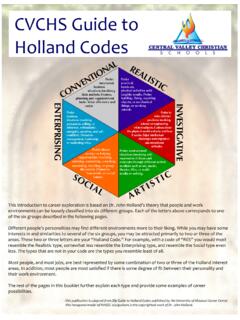Transcription of Managing Risk Positively A Guide for Staff in Health and ...
1 Managing Risk Positively A Guide for Staff in Health and Social Care Isle of Wight Council Community Services and Isle of Wight NHS Primary Care Trust Authors: Maurice Dix and Simon Smith 1 May 2009 Revised 2nd June 2009 1st Sept 2010 Next Review: 1st Sept 2011 Page 2 of 38 Health and Social Care services on the Isle of Wight should work with adults with a disability and older people to support them be informed exercise choice make their own decisions improve their life chances learn from experience change and grow in confidence make use of opportunities collaborate with others promote their independence develop new skills be aware of their rights and responsibilities express their views Page 3 of 38 Contents 1. Policy Statement 4 2. Introduction 5 3. What is risk? 7 4. What is Managing risk Positively ? 8 5. Principles of working with risk 10 6. Framework for positive management of risk identification, assessment & management of risk and the review of incidents 11 Appendices 1.
2 Underlying Principles 18 2. Defensible Decisions 19 3. Professional Competency 20 4. Legislation and Legal Principles 21 5. Risk Enablement Panel & Risk Management Tool 25 6. Illustrative case studies 34 References 36 The authors acknowledge the contribution of the independent consultant Steve Morgan and Gateshead Council in the content and structure of this Guide . More information about Managing risk Positively can be found at the web site: Page 4 of 381. Policy Statement This Guide has been developed to encourage Staff in all services to actively explore with service users and their carers the potential benefits of Managing risk Positively . It aims to promote the effective identification, assessment and management of risk by Health and Social Care Support Services that can be supported through policy, procedures and practical tools. This complements existing clinical and operational risk assessment guidelines that already exist.
3 The aims and scope of the Guide are: To provide a coherent multi-agency framework which will establish a consistent approach to the processes of risk assessment, risk management and risk taking whatever the context and environment of care / support. To promote and support the safety and security of users of services, those who care for them and all those who may come into contact with them. To raise awareness of the role of risk assessment / management in the provision of evidence based care, which is meaningful to the individual and supportive to primary carers. To promote, and thereby support inclusive decision making as a collaborative and empowering process, which is fully attentive to the individual s perspective and to the views of the primary carers. To enable and support the positive management of risks where this is fully endorsed by the multi-disciplinary team as having positive outcomes.
4 To promote and enhance safer working environments. To provide a shared theoretically sound basis for multi-agency training and for the monitoring and auditing of service responses. To promote the adoption by all Staff of defensible decisions rather than defensive decisions . Review of this Guide : The Guide will be reviewed annually. The next review will take place in September 2011. Page 5 of 382. Introduction The saying nothing ventured, nothing gained makes the point that unless someone takes a risk and tries new activities, they will never know of the positive benefits that might result. In our society, people are encouraged to travel widely, take part in regular leisure and sporting activities, go to college, develop careers and have families. These are all activities that don t just happen, but mean people have to take risks to achieve their aspirations.
5 For many people taking risks is an accepted part of life. However people with a disability and older people are often discouraged from taking risks, either because of their perceived limitations or fear that they or others might be harmed. Changes in society s attitude towards disability, social care and Health policy now mean that people with a disability and older people are being actively encouraged to increase their independence in their daily activities and decisions about the services they receive. The focus is now more on enhancing people s abilities rather than concentrating on their disabilities. Historically, social care has been good at providing services that minimised risk. However, personalisation means that in the future Social Care (and Health Services) have to work towards providing choices rather than services. 1 This Guide is concerned with setting out the approach that the Isle of Wight Council and PCT expect its Staff to adopt towards the issue of risk when they work with adults with a disability and older people.
6 When implementing this Guide in day-to-day practice, the Isle of Wight Council and PCT recognise that any risk-taking approach must be balanced with their responsibilities in relation to safeguarding adults and children, care standards and Health and safety legislation. In addition, whilst this Guide will encourage the Council s leisure, sport and cultural services to work with social care services and their users around the issue of risk, it should not lead them to feel they have to individually risk assess every person who use their services outside of their duty of care towards all consumers. We recognise that to do so would be both impractical and potentially discriminatory. However there may be circumstances in which some services provided may need to assess the risk to an individual. They will explain their justification for 1 Safeguarding Adults: A consultation on the review of the no secrets guidance : DoH / Dignity and Safety / Lucy Bonnerjea 14 October 2008 Page 6 of 38this and do everything practical to enable the individual s inclusion in the activities in which they want to take part.
7 The Council and PCT s Services will also endeavour through their commissioning arrangements and Service Level Agreements to encourage the individuals, agencies and services it funds, or with which it contracts, to manage risks Positively . The Guide will support the Council and PCT to fulfil their responsibilities under the Disability Discrimination Acts 1995 and 2005 and the Mental Capacity Act 2005. The Mental Capacity Act 2005 and its Code of Practice provides a statutory framework for people who lack capacity to make decisions for themselves. The Guide supports the Human Rights Act 1998 as it empowers people make decisions for themselves where possible and places individuals at the heart of the decision making process. The Local Authority and PCT owe a duty of care to all their service users. Any risk taking has potential legal implications in negligence. However, these can be minimised where there is a positive approach which generates a clear trail of written records showing the issues and solutions which have been considered, and there is an explicit and justifiable rationale for risk management decisions.
8 The fundamental principle of this Guide is that support is provided to individuals to enable them to receive personalised care / support that meets their needs regardless of their disability, age, gender, ethnicity, religion or sexuality. This also applies to people with a particular medical or psychiatric diagnosis. This support must exist within a framework of risk assessment and management that is collaborative, transparent and enabling. Page 7 of 383. What is risk? Risk is the possibility that an event will occur with harmful outcomes for a particular person or others with whom they come into contact. A risk event can have harmful outcomes because of: risks associated with impairment or disability such as falls Health conditions or mental Health problems accidents, for example, whilst out in the community or at a social care / support service risks associated with everyday activities that might be increased by a person s impairment or disability the use of medication the misuse of drugs or alcohol behaviours resulting in injury, neglect, abuse, and exploitation by self or others self harm, neglect or thoughts of suicide.
9 Aggression and violence poor planning or service management The type of outcome depends on the nature of the person, their relationships with others and the circumstances in which they find themselves. Risk is often thought of in terms of danger, loss, threat, damage or injury. But as well as potentially negative characteristics, risk-taking can have positive benefits for individuals and their communities. Risk can be minimised by the support of others, who can be Staff , family, friends, etc. However, in promoting independence, individual responsibility for taking risks must be a balance between safeguarding someone from harm and enabling them to lead a more independent life where they effectively manage risks themselves. A balance therefore has to be achieved between the desire of people to do everyday activities with the duty of care owed by services and employers to their Staff and to users of services, and the legal duties of statutory and community services and independent providers.
10 As well as considering the dangers associated with risk, the potential benefits of risk-taking have to be identified ( nothing ventured, nothing gained ). This should involve everyone affected adults who use services, their families and practitioners. Page 8 of 384. What is Managing risk Positively ? Managing risk Positively is: weighing up the potential benefits and harms of exercising one choice of action over another, identifying the potential risks involved, and developing plans and actions that reflect the positive potential and stated priorities of the service user. It involves using available resources and support to achieve the desired outcomes, and minimising the potential harmful outcomes. It is not negligent ignorance of the potential is usually a very carefully thought out strategy for Managing a specific situation or set of circumstances.











